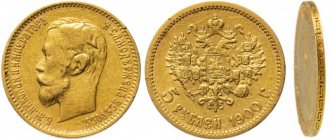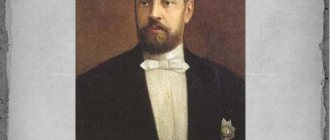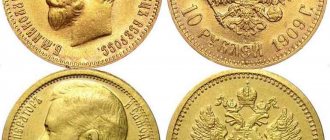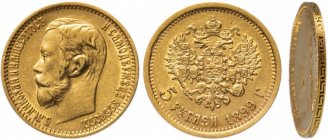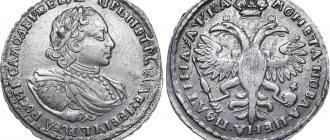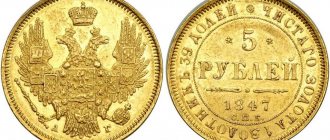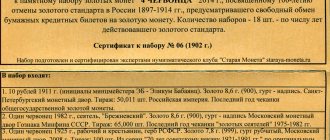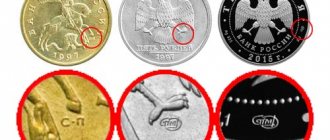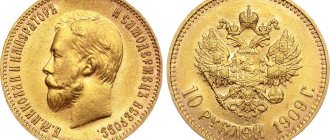Greetings!
The last Russian emperor is a special figure in our history; interest in his era does not fade over time. The world of numismatics is no exception. Nicholas II not only issued gold coins, which were the last for the old system, but also changed the entire monetary system of the country. All this has led to the fact that even today not a single numismatist will refuse such a specimen for his collection, despite the price. I propose to discuss one of the most common coins of that period - 10 rubles of Nicholas II (gold): price, history, characteristics.
History of appearance
In 1897, the financial reform of Nicholas II came to completion. During this time, the monetary system underwent major changes:
- Paper money was partially withdrawn from circulation and replaced with gold. For these purposes, 18 times more gold coins were minted than in previous years. The main burden fell on the mint in St. Petersburg, but it could not cope with such volumes. The government was forced to order additional coinage abroad.
- During the reform of Nicholas II, 10 rubles lost significant weight (they became 4.3 grams lighter).
- Simultaneously with the new, lighter 10 rubles, the mint issued a small batch of ten-ruble notes of the old weight.
- With the change in the weight of 10 rubles of Nicholas II, they lost the proud name of “imperials” and became simply “chervonets” (from the name of the alloy - “red gold”).
One of the most interesting historical mysteries is connected with 10 rubles made from gold from the time of Nicholas II. Numismatists drew attention to the fact that the number of declared coins long ago exceeded the official circulation.
What also seems suspicious is the fact that even today you can find 10 Nikolaev rubles in almost perfect condition. Of course, sometimes this is explained by the fact that with the fall of the power of Emperor Nicholas II, ordinary people kept 10 rubles as a gold reserve for a rainy day.
However, there are very plausible rumors about the use of the original dies outside the mint, separate from the official mintage.
According to one version, the stamps fell into the hands of the Bolsheviks, who minted 10 rubles of the model of Nicholas II in order to use them for payments with foreign partners. At that time, Soviet money did not inspire confidence (even within the country), so the version is quite plausible. Bitkin also adheres to this in his reference book. According to his information, the Soviet government in the period 1925-1926. minted 2 million 10 rubles of the type from the time of Nicholas II.
How to spot a fake
Numismatists claim that this is quite easy to do if you are very careful and understand the art of coinage. In their opinion, in the originals and fakes there is a big difference between the images of the emperor, so if you compare both coins, you can see the difference in the drawn lines, contours, etc. In addition, the new copies use cheaper gold, which sometimes contains impurities other metals. And any jeweler will determine this. Therefore, numismatists, before giving money for 10 royal rubles, turn first of all to specialists for advice.
Slitok.Gold store specialists will help you understand all the issues, including being able to easily determine where the original is and where the fake is.
Characteristics
The era of the reign of Nicholas II is a very interesting period for numismatists. During this time, a huge number of 10 ruble coins made of gold were put into circulation. Most of them were minted using the same die.
From time to time, numismatists find ten rubles. tsarist era with differences in coinage, but most often they are caused by surface wear.
General characteristics:
- denomination - 10 rubles;
- dimensions: diameter - 2.25 cm, weight - 8.6 g, thickness 0.17 cm;
- material - gold (900 standard).
| Years of manufacture | Circulation, thousand | Mint | Designation according to the Bitkin catalog | Peculiarities |
| 1898 | 200 | St. Petersburg | 3 | Mintzmeister - Apollo Grashof |
| 1899 | 27 600 | 4, 5, 6 | This year, coins with the initials of three mintzmeisters were issued, so in circulation you can find 10 rubles with the initials “EB”, “FZ”, “AG”. Although 10 rubles in gold with “FZ” and “AG” are less common, the price of all three varieties is not much different. | |
| 1900 | 6021 | 7 | ||
| 1901 | 2377 | 8,9 | Varieties: FZ and AR | |
| 1902 | 2019 | 10 | ||
| 1903 | 2817 | 11 | ||
| 1904 | 1024 | 12 | ||
| 1905 | Not minted | |||
| 1906 | 10 pieces | St. Petersburg | 13 | A very rare gold coin from the era of Nicholas II. Today this is the most expensive 10 rubles. The price is determined during the bidding process. Typically, the price exceeds hundreds of thousands of dollars. |
| 1907 | Not minted | |||
| 1908 | ||||
| 1909 | St. Petersburg | 14 | The only year when the exact circulation size is unknown | |
| 1910 | 100 018 | 15 | ||
| 1911 | 50 011 | 16 | ||
Ten rubles “in a new way”
The weight of a regular 10 ruble coin is 5.65 grams.
Until recently, 10 rubles were presented in the form of paper bills and metal coins. However, according to the resolution of the Central Bank, from October 1, 2009, ten-ruble coins of a new type were introduced into circulation. Therefore, the “old” monetary media were completely replaced and gradually forced out of circulation.
What is the reason for this innovation? The fact is that paper tens are very short-lived and wear out quickly - after a year, a brand new “crispy” piece of paper in your hands turns into an erased ten of unesthetic “appearance”. And replacing worn-out banknotes also costs money! The introduction of new ten-ruble bills will save approximately 18 billion rubles. After all, a metal coin can retain its “marketable” appearance for 25–30 years.
“Old” and “new” 10 ruble coin: main differences
As you can see, the weight of the new ten-ruble coin is slightly less than the weight of the 1991 coin. In addition, the size of the new “chervonets” has also decreased slightly. According to the leadership of the Central Bank, the use of new technologies will eventually spread to the issue of coins with denominations of two and five rubles. As a result of such changes, the profitability of metal coin production will significantly increase.
Appearance and Design
All years from 1898 to 1911, the same stamp was used to mint 10 rubles in gold, so the appearance of the coins of Nicholas II is no different. On both sides of the coin there is a protruding serrated edge along the edge; the teeth in the form of the letter of the Greek alphabet “omega” (Ω) are turned inward. Detailed appearance 10 rub. Nicholas II can be clearly seen in the photo.
Obverse
The front side shows the profile of Nicholas II. The face is turned to the left. Along the edge there are inscriptions in a semicircle: “B.M. (By the grace of God) Nicholas II Emperor" and "And the Autocrat of All Russia."
Reverse
The design of the reverse (back side) is traditional for the era of Nicholas II: the main area is occupied by the image of the small imperial coat of arms. Below it is printed the denomination (10 rubles) and the year of circulation.
edge
On the edge there is the inscription “pure gold 1 spool 78.24 shares” and the initials of the mintzmeister.
How much do domestic coins of different denominations weigh?
It is noteworthy that the mass of coins is not a constant value. For example, the weight of a ten-ruble coin from different years of issue may be different. And if you take into account that over time, metal tends to wear off, then you can easily distinguish a brand new coin from a “used” one for several years. It also happens that the weight of the coin increases slightly because a layer of dirt forms on its surface.
So, let's find out the weight of a penny, ruble and other Russian coins:
- 1 kopeck – 1.47 g
- 5 kopecks – 2.55 g
- 10 kopecks (smooth rib) – 1.87 g
- 10 kopecks (serrated edge) – 1.95 g
- 50 kopecks (smooth rib) – 2.80 g
- 50 kopecks (serrated edge) – 2.92 g
- 1 ruble – 3.24 g
- 2 rubles – 5.13 g
- 5 rubles – 6.50 g
- 10 rubles (2011 coin) – 5.65 g
- 10 rubles (anniversary “chervonets” produced in 2008) – 8.20 g
The smallest mass is the 1 kopeck coin (1.47 g). A 5-kopeck coin weighs more than a ten-kopeck coin (2.55 g versus 1.87 - 1.95 g). How much does a 2 ruble coin weigh compared to a 5 ruble coin? Just 1.37 grams less. The difference in weight “categories” between the ruble and 2 ruble coins is slightly larger – approximately 1.89 g.
The weight of a 50-kopeck coin with a smooth edge and a coin of the same denomination with a jagged edge differs by only 0.12 g (the advantage is in favor of the second type).
Types of coins and their prices
There are not many varieties of 10 rubles made from the gold of Nicholas II. First of all, 10 rubles are distinguished by the initials of the mintsmaker. Another very rare type, the price of which is amazing, is 10 rubles minted in 1906. Quality - Proof. Today it is almost impossible to find this coin at auction; all of them have been in collections for a long time.
The last time collectible 10 rubles in gold from 1906 was put up for auction in 2015 at a price of 200 thousand dollars. It is difficult to predict how much it costs now, but the price will clearly be much higher.
Edge with the initials “EB”
Edge with the initials “FZ”
Edge with the initials “AG”
Weight 10 rubles
10 rubles of the Bank of Russia
10 rubles of the Bank of Russia
Answers to the question “How much do 10 rubles weigh?” Regarding coins of the Russian Federation intended for circulation, there may be three. First of all, let's remember 10 rubles regularly minted. They were first released in 2009, and since then their metal (steel with brass coating) and weight (5.63 grams) have not changed.
Where can I buy or sell, price
You can buy or sell your 10 gold rubles of Nicholas II at a good price either to an individual (through an advertisement, forums) or to organizations. The choice of the latter is huge: banks and pawn shops willingly buy gold coins in good condition (the price will be lower). The price depends on the year and condition of the gold.
Where can you sell or buy coins (at an objective price):
- central forum of numismatists (https://coins.su/forum/),
- treasure hunters forum (reviewdetector),
- online trading platforms (Tiu, au.ru, Avito, Ebay, Meshok and others),
- auctions Konros, MonetShop, Efimok, Wolmar, Gelos, Numisma.
Price table depending on condition
The minimum price is 16,000 rubles, the maximum price is unknown.
| Years of manufacture | Variety | VG | F | VF | XF | AU | UNC |
| 1898 | 16 000 | 24 446 | 25 612 | 27 508 | 52 022 | ||
| 1899 | AG | 23 840 | 27 131 | 26 273 | 31 761 | ||
| Federal Law | 26 055 | 26 948 | 25 589 | 33 189 | |||
| EB | 17 638 | 25 395 | 29 424 | 29 793 | |||
| 1900 | 24 641 | 26 507 | 28 352 | 31 432 | |||
| 1901 | AR | 21 050 | 28 583 | 28 819 | 39 701 | ||
| Federal Law | 17 244 | 23 915 | 27 183 | 30 636 | |||
| 1902 | 15 562 | 24 584 | 26 463 | 34 532 | |||
| 1903 | 19 098 | 25 508 | 34 556 | 47 310 | |||
| 1904 | 29 000 | 29 503 | 29 566 | 46 377 | |||
| 1905 | Not minted | ||||||
| 1906 | It is impossible to determine the price due to extreme rarity | ||||||
| 1907 | Not minted | ||||||
| 1908 | |||||||
| 1909 | 37 667 | 36691 | 36 837 | 51 621 | |||
| 1910 | 63 800 | 70641 | 113 561 | 124 427 | |||
| 1911 | 23 314 | 20 817 | 26752 | 32 531 | 31 647 | ||
The price tag for Nikolaev gold tens will be determined after assessing their condition. In the worst case scenario, 10 rubles of Nicholas 2 can be sold by the weight of the metal (gold).
New 10 ruble coin
Previously, there were no 10 ruble metal money; instead, 10 ruble paper bills were in circulation. At the end of 2009, 10 ruble metal money was introduced. Their paper counterpart is almost impossible to find these days. They replaced 10 ruble money for economic reasons - metal ones are much more durable than paper ones.
Comparative table of old and new 10 ruble coins
| Year of issue | Material from which the 10 ruble coin is made | Weight | Diameter (mm) | Thickness (mm) |
| 1991 | The circle inside is made of copper and zinc, the rim is made of copper and nickel. | Two types of 10 ruble coins were issued. One of them weighs 6.25 g, the second weighs 3.75 g. | Just like with the weight, there were two diameter options: the first was 25, the second was 21. | The first version of the coins had a thickness of 1.95 mm, the second - 1.45. |
| 1992 | The circle inside is made of copper and zinc, the rim is made of copper and nickel. | Weighs 3.5 g. | 22 | 2,2 |
| 1993 | The circle inside is made of copper and zinc, the rim is made of copper and nickel. | Weighs 3.5 g. | 22 | 2,2 |
| 2009 | The entire coin is made of steel coated with a special brass coating. | Weighs 5.65 g. | 22 | 2,2 |
Types of golden chervonets of tsarist times
In 1701, Peter I resumed the production of gold coins as banknotes. They were intended primarily for foreign trade.
The tradition of issuing royal gold chervonets was subsequently adhered to by all Russian monarchs without exception. However, Russia began to mine its own gold only closer to the second half of the 18th century, so until the Witte reform in 1895, silver was the basis for commodity-money payments. And royal gold coins were minted in small quantities.
Traditionally, the royal profile was located on the obverse of the chervonets, and the state emblem was located on the reverse.
Designation of the degree of rarity of coins according to the Bitkin catalog:
- R – quite rare, 50-100 pieces;
- R1 – rare, 20-49 pieces;
- R2 – very rare, 10-19 pieces;
- R3 – very rare, 4-9 pieces;
- R4 – the rarest, 2-3 pieces;
- Un is unique, the only copy.
Peter I
Starting from 1701, gold money was issued almost annually in relatively small editions from several thousand to several tens of thousands of pieces. Tsar Peter's coins were minted in denominations of 1 chervonets and 2 chervonets until 1716 from precious metal of 969-980 standard. In terms of weight, they were brought into line with the European ducat then in use.
The issue was carried out at the Red and Kadash mints. The weight of the samples is 3.47 and 6.94 g, respectively, their diameter is 23-24 mm. Since 1718, the royal gold chervonets have been known as 2 rubles, made of 781 standard metal weighing 4.1 grams.
All copies from the time of Peter I are classified as very rare, their price skyrockets.
They were made using artisanal methods; there are a great many varieties of coins, even within the same circulation. Designation according to Bitkin’s catalog – R1-Un. Price from 50 thousand to 9 million.
Peter II
Under Peter II, from 1718 to 1728, low-grade two-ruble coins were minted. And only in 1729 were full-fledged royal chervonets issued with a circulation of 17 thousand pieces. The gold ones were of 981st standard. The mass of the object is 3.47 g, the diameter is 2 cm. Twice more, in 1727-28, gold coins of two-ruble denomination were minted with a circulation of 9,397 copies, 781-carat gold. Weight – 4.1 g, diameter – 2 cm. Designation according to Bitkin’s catalog: R1, R3. Price from 0.5 to 6.8 million.
Anna Ioannovna
Under Empress Anna Ioannovna, gold chervonets were minted from 968-carat metal. Three circulations are known - in 1730 (8764 pieces), 1738 (4002 pieces) and 1739 (65,953 pieces) at the Kadashevsky and St. Petersburg courtyards. The coins weigh 3.47 grams, diameter – 2 cm. Bitkin: R2, R4.
Price 0.28–1.3 million in national currency.
Elizaveta Petrovna
Under Elizabeth, royal gold coins worth 1 chervonets were minted from 1742 to 1757 from 968-carat gold, weighing 3.47 grams, with a diameter of 20-23 mm. Circulations ranged from 489 to 18,794 pieces. Bitkin: R2-R4. In 1749 and 1751, commemorative double chervonets were also issued with a circulation of 600 and 3360 copies, respectively. Designation according to Bitkin’s catalog – R1-R3.
The production of royal ruble coins began in 1755, denominations: half, 1, 2, 5 half-imperials and 10 imperials from 917-carat alloy. Gold coins were issued by the St. Petersburg and Moscow mints. They weighed at the rate of 1 ruble. – 1.6 grams. Circulation ranges from 5-50 thousand copies, the larger the denomination, the smaller the circulation of the issue. Bitkin: R-R3.
The price of royal coins of the Elizabethan era ranges from 30 thousand to 12.75 million.
Peter III
During the reign of Peter III, the issue of royal gold money was made only once - in 1762. Money was minted in denominations of 5, 10 rubles and chervonets. Gold alloy samples – 917 and 978 for chervonets. Circulations: 9482, 25,876 and 10,042 pieces respectively. The weight of chervonets was 3.47 grams, ruble denominations were 8.28 and 16.57 g. Mints - Moscow and St. Petersburg. Designation according to Bitkin's catalog: R1-R2. The price of copies now ranges from 1 to 3.5 million.
Catherine II
During the reign of Catherine II, in 1762, the weight of the royal five- and ten-ruble coins was forced to be reduced in order to bring them into line with silver banknotes in terms of metal value. At that time, the price of gold relative to silver was 1:15. Gold ones became lighter by about 20%. Their weight was 6.54 and 13.09 grams. The fineness of the metal alloy is 917.
In total, during the years of Catherine’s reign, 1,075,753 ten-ruble imperials and 927,378 five-ruble half-imperials were made. Production took place at the Moscow and St. Petersburg courtyards. Designation according to Bitkin: R-R3.
Expert opinion
Alexander Ivanovich
Private collector with 4500+ coins and bonds in his personal collection. Knows the value of each of them today.
The minting of royal chervonets was significantly reduced due to their unprofitability. In 1763, 50 thousand copies of them were produced, in 1766 - 28,334 pieces. and in 1796 – 39,981 pieces. made of 978 gold. All chervonets were issued by the St. Petersburg Mint, Bitkin: R-R1.
Paul I
Having ascended the throne, Paul I began to change the appearance of money. According to historians, the emperor was embarrassed by his appearance, so the motto of the knightly order of the Templars was placed on the obverse instead of the royal profile. The reverse became the obverse, but the traditional eagle was soon replaced. Instead, they began to mint an ornament in the form of four “Ps”.
The composition of gold has also changed - for the production of royal 5 and 10 rubles. We used a purer gold alloy, 986 standard. In total, from 1796 to 1801, the following were issued: half-imperials - 510,880, weighing 6.08 grams, and chervonets - 162,220, weight in grams - 3.49. The issue was carried out by the Bank and St. Petersburg mints. Bitkin R-R4, price reaches 5 million.
Alexandra I
Under Alexander I, royal imperials and semi-imperials were minted in the periods from 1802 to 1806 and from 1817 to 1831. The design has undergone changes again. The obverse was decorated with 4 shields, on the reverse there is the inscription “state Russian coin”. Later, in 1817, the shields were replaced with a new coat of arms - an eagle with lowered wings. Gold 917 standard, weight - 6.54 and 12.17 g. The total circulation was: 5 rubles. – 4,555,283 pcs., 10 rub. – 201,462 pcs. Bitkin R-R4, price from 20 thousand to 5 million.
Alexandra III
Alexander III was crowned in 1881. He revived the minting of the obverse and reverse of the royal gold in the traditional design, with a profile and coat of arms. From 1881 to 1886 inclusive, banknotes in denominations of 3 and 5 rubles were minted. made of 917 standard metal. Since 1987, instead of the three-ruble coin, the issue of the imperial began, but the gold standard of the remaining two denominations was reduced to 900.
During the 13 years of the sovereign's reign, the following were minted: 3 rubles. weighing 3.93 g - 124,037 pcs., 5 rubles. weighing 6.45 g – 31 019 115 pcs., 10 r. weighing 12.9 g - 1,424,654 copies. Depending on individual characteristics and the degree of preservation, the price for them ranges from 16 thousand to 4.3 million. Designation according to the Bitkin catalog: from standard (not rare) to R4.
Nicholas II
The reign of Emperor Nicholas II was marked by the transfer of the monetary system to the gold standard and the appearance of several new denominations of chervonets: 7.5 and 15 rubles, as well as the largest coins in the entire history of tsarist Russia - 2.5 imperial and 37.5 rubles, or 100 francs True, these denominations were classified as donative (gift) signs. Very few of them were minted - 476 and 235 copies. The price for such items is 3–18 million rubles.
Gold purity – 900, manufacturer – St. Petersburg Mint. Over the entire period of his reign, the issue of gold chervonets amounted to: 5 rubles - more than 112 million pieces (more accurate information is not available due to the loss of data for 1909), 7.5 rubles. – 16,829,000 pieces, 15 rubles – 11,900,033 pieces. The price ranges from 3 thousand to 5.8 million for individual copies.

